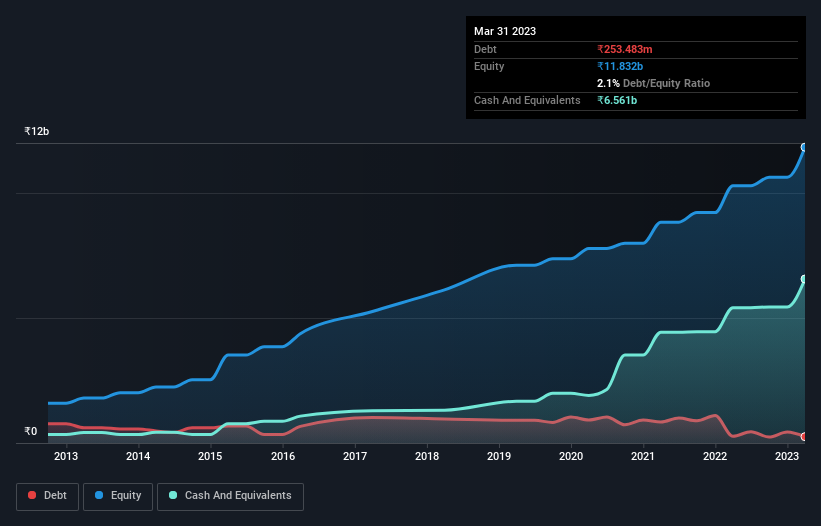Legendary fund manager Li Lu (who Charlie Munger backed) once said, 'The biggest investment risk is not the volatility of prices, but whether you will suffer a permanent loss of capital.' So it might be obvious that you need to consider debt, when you think about how risky any given stock is, because too much debt can sink a company. Importantly, Cera Sanitaryware Limited (NSE:CERA) does carry debt. But should shareholders be worried about its use of debt?
When Is Debt Dangerous?
Debt is a tool to help businesses grow, but if a business is incapable of paying off its lenders, then it exists at their mercy. Ultimately, if the company can't fulfill its legal obligations to repay debt, shareholders could walk away with nothing. However, a more usual (but still expensive) situation is where a company must dilute shareholders at a cheap share price simply to get debt under control. Of course, plenty of companies use debt to fund growth, without any negative consequences. When we think about a company's use of debt, we first look at cash and debt together.
Check out our latest analysis for Cera Sanitaryware
How Much Debt Does Cera Sanitaryware Carry?
The image below, which you can click on for greater detail, shows that Cera Sanitaryware had debt of ₹253.5m at the end of March 2023, a reduction from ₹266.8m over a year. However, its balance sheet shows it holds ₹6.56b in cash, so it actually has ₹6.31b net cash.

How Healthy Is Cera Sanitaryware's Balance Sheet?
According to the last reported balance sheet, Cera Sanitaryware had liabilities of ₹3.93b due within 12 months, and liabilities of ₹999.2m due beyond 12 months. Offsetting this, it had ₹6.56b in cash and ₹1.92b in receivables that were due within 12 months. So it can boast ₹3.55b more liquid assets than total liabilities.
This short term liquidity is a sign that Cera Sanitaryware could probably pay off its debt with ease, as its balance sheet is far from stretched. Succinctly put, Cera Sanitaryware boasts net cash, so it's fair to say it does not have a heavy debt load!
On top of that, Cera Sanitaryware grew its EBIT by 33% over the last twelve months, and that growth will make it easier to handle its debt. There's no doubt that we learn most about debt from the balance sheet. But ultimately the future profitability of the business will decide if Cera Sanitaryware can strengthen its balance sheet over time. So if you're focused on the future you can check out this free report showing analyst profit forecasts.
Finally, a business needs free cash flow to pay off debt; accounting profits just don't cut it. Cera Sanitaryware may have net cash on the balance sheet, but it is still interesting to look at how well the business converts its earnings before interest and tax (EBIT) to free cash flow, because that will influence both its need for, and its capacity to manage debt. Over the most recent three years, Cera Sanitaryware recorded free cash flow worth 78% of its EBIT, which is around normal, given free cash flow excludes interest and tax. This cold hard cash means it can reduce its debt when it wants to.
Summing Up
While we empathize with investors who find debt concerning, you should keep in mind that Cera Sanitaryware has net cash of ₹6.31b, as well as more liquid assets than liabilities. And it impressed us with its EBIT growth of 33% over the last year. So is Cera Sanitaryware's debt a risk? It doesn't seem so to us. Over time, share prices tend to follow earnings per share, so if you're interested in Cera Sanitaryware, you may well want to click here to check an interactive graph of its earnings per share history.
If, after all that, you're more interested in a fast growing company with a rock-solid balance sheet, then check out our list of net cash growth stocks without delay.
New: AI Stock Screener & Alerts
Our new AI Stock Screener scans the market every day to uncover opportunities.
• Dividend Powerhouses (3%+ Yield)
• Undervalued Small Caps with Insider Buying
• High growth Tech and AI Companies
Or build your own from over 50 metrics.
Have feedback on this article? Concerned about the content? Get in touch with us directly. Alternatively, email editorial-team (at) simplywallst.com.
This article by Simply Wall St is general in nature. We provide commentary based on historical data and analyst forecasts only using an unbiased methodology and our articles are not intended to be financial advice. It does not constitute a recommendation to buy or sell any stock, and does not take account of your objectives, or your financial situation. We aim to bring you long-term focused analysis driven by fundamental data. Note that our analysis may not factor in the latest price-sensitive company announcements or qualitative material. Simply Wall St has no position in any stocks mentioned.
About NSEI:CERA
Cera Sanitaryware
Manufactures, sells, and trades in building material products in India.
Flawless balance sheet established dividend payer.
Market Insights
Community Narratives


Recently Updated Narratives


Q3 Outlook modestly optimistic


Alphabet: The Under-appreciated Compounder Hiding in Plain Sight


MINISO's fair value is projected at 26.69 with an anticipated PE ratio shift of 20x
Popular Narratives


The company that turned a verb into a global necessity and basically runs the modern internet, digital ads, smartphones, maps, and AI.


MicroVision will explode future revenue by 380.37% with a vision towards success



